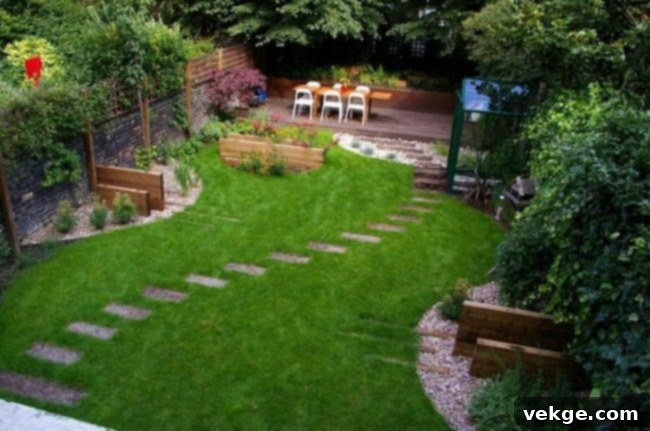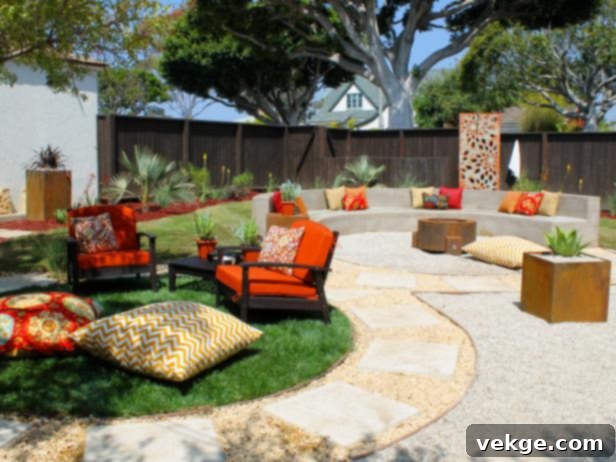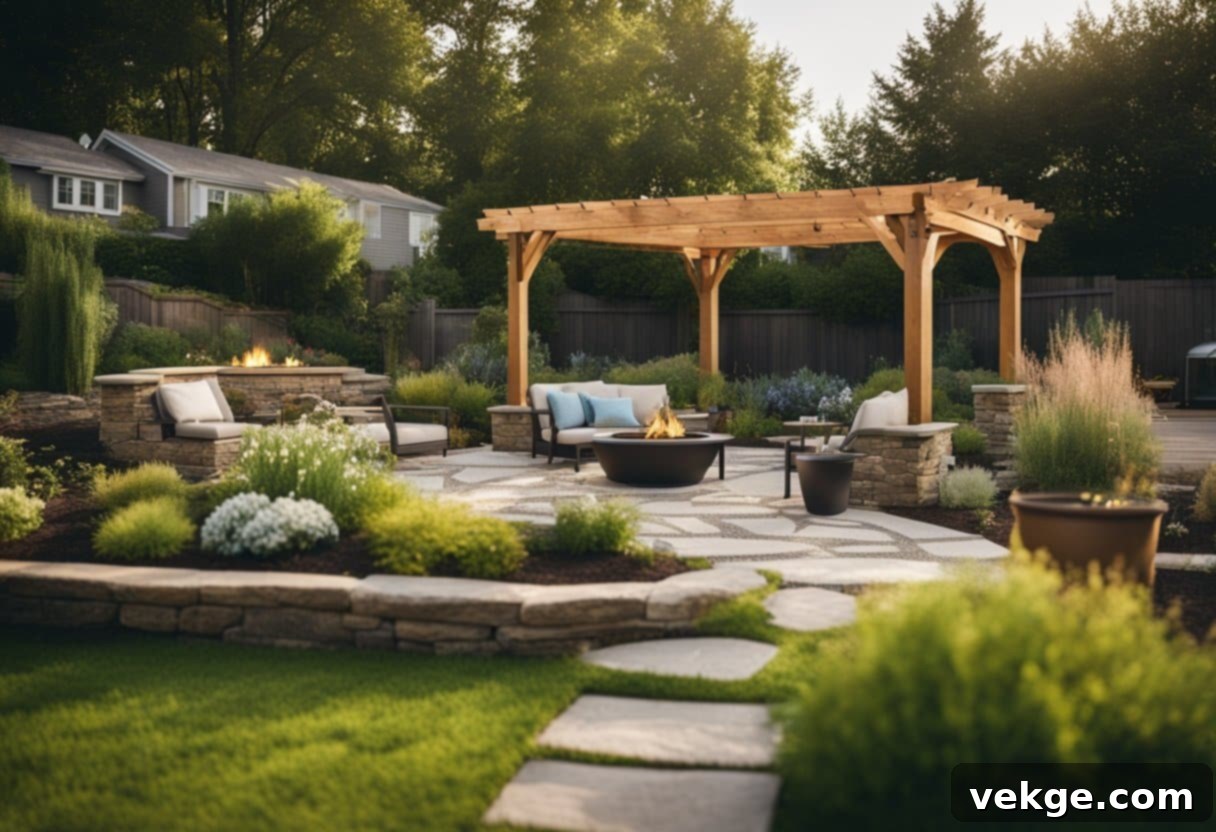DIY Backyard Transformation: Simple Projects to Create Your Dream Outdoor Oasis
Imagine stepping into your backyard and feeling an immediate sense of peace and beauty – a personal oasis designed just for you. Transforming your outdoor space into this dream retreat doesn’t require a hefty budget or extensive professional help. With a few beautifully simple and accessible DIY backyard projects, anyone can enhance their home’s outdoor appeal and functionality, creating a more inviting and enjoyable environment.
This guide explores five rewarding categories of DIY backyard projects, from crafting charming garden pathways and vibrant flower beds to setting up cozy fire pits and ambient lighting. These ideas are meticulously designed to elevate any backyard, regardless of its current state. The best part? Many of these transformations can be completed over a weekend, without the need for extensive tools or expensive materials. By following these practical and creative ideas, even a novice can infuse a touch of elegance, comfort, and personal style into their backyard, making it the perfect extension of their home.
Designing Your Backyard Space for Optimal Enjoyment

Effective backyard design is the foundation for any successful outdoor transformation. It involves a thoughtful approach to selecting a cohesive theme and meticulously planning the layout. Both aspects are crucial to ensuring all elements work together harmoniously, creating a balanced, appealing, and functional outdoor living area.
Choosing a Theme: Setting the Tone for Your Outdoor Sanctuary
Selecting a distinct theme is the initial and most vital step, as it sets the overall tone and direction for your entire backyard project. Your chosen theme should deeply resonate with your personal style, complement the existing architecture of your home, and reflect the desired atmosphere for your outdoor sanctuary. Whether you envision a rustic country garden, a sleek urban oasis, a vibrant tropical paradise, or a tranquil Zen retreat, the theme will guide all subsequent decisions, from material selection to plant choices.
Materials play a significantly pivotal role in bringing your theme to life. For instance, incorporating natural stone, reclaimed wood, and weathered metals can beautifully enhance a rustic, farmhouse, or traditional garden theme, adding character and warmth. Conversely, utilizing sleek concrete, minimalist furniture, glass accents, and polished metals will perfectly complement modern or contemporary themes, promoting a clean and sophisticated aesthetic.
The color palette is another essential factor that greatly influences the mood and perception of your outdoor space. Vibrant, bold colors like fuchsias, oranges, and deep blues might suit a tropical or bohemian theme, evoking energy and playfulness. In contrast, a palette of muted tones, such as grays, whites, and earthy greens, can beautifully complement a minimalist or Scandinavian design, fostering a sense of calm and spaciousness. Admer Construction Group often recommends creating a detailed mood board. This visual tool allows you to gather images of different elements—materials, colors, furniture, plants—and see them together, ensuring they align perfectly with your chosen theme and vision before any physical work begins.
Planning and Layout: Maximizing Functionality and Flow
Meticulously laying out your backyard space requires careful attention to detail, considering both aesthetics and practical functionality. Clearly defining functional zones—such as dedicated dining areas, comfortable lounging spaces, active play zones for children, and serene garden beds—is paramount. Using strategic elements like pathways, low walls, screens, or even distinct planting arrangements can help effectively segregate these zones, providing a sense of order and purpose to each area. This thoughtful segregation prevents the backyard from feeling like a single, undifferentiated space, making it more intuitive and enjoyable to use.
Scale and proportion are integral to creating a visually pleasing and balanced design. It’s crucial to ensure that larger structures, such as a grand pergola, a custom deck, or an impressive water feature, are harmoniously balanced by smaller plants, decorative items, and open spaces. Overcrowding a small backyard with large features can make it feel cramped, while sparse additions to a vast area might leave it feeling empty. Admer Construction Group emphasizes the critical importance of leaving sufficient walking space around all features and considering sunlight exposure when positioning plants and seating areas. Mapping out sun and shade patterns throughout the day helps in placing sun-loving plants where they will thrive and creating shaded retreats where they are most desired.
To add depth and visual interest to your outdoor space, incorporate a variety of textures and heights. Tall, architectural plants against a backdrop, mid-level shrubs, and vibrant groundcovers offer varied perspectives and keep the space engaging and dynamic throughout the seasons. Plan pathways and sitting areas using materials that complement your chosen theme for a unified and cohesive look. For example, permeable paver pathways can guide visitors through a garden, while a stone patio can serve as the central gathering point. Thoughtful planning also includes considering privacy needs, potential noise reduction strategies, and future growth of plants, ensuring your backyard remains beautiful and functional for years to come.
DIY Garden and Landscaping: Cultivating Beauty and Structure

Creating a beautiful and sustainable garden and landscape in your backyard involves more than just planting flowers; it requires careful plant selection tailored to your environment and the strategic design of pathways and edging to define spaces and add structure.
Plant Selection: Choosing the Right Green Companions
Choosing the right plants is perhaps the most crucial step for any thriving garden. Begin by thoroughly understanding the climate zone, average rainfall, and specific soil conditions (e.g., sandy, clay, loamy, acidic, alkaline) in your area. Conducting a simple soil test can provide invaluable information, helping you determine which plants will not only survive but truly thrive in your unique environment.
Native plants are often the best choice for a sustainable and low-maintenance garden. They are naturally adapted to local conditions, requiring significantly less water, fewer fertilizers, and minimal pest control once established. Perennials are another excellent option, as they return year after year, reducing the need for constant replanting and providing enduring beauty. Consider also drought-tolerant plants, especially if you live in a drier climate, to conserve water.
When selecting plants, think beyond individual species; consider their collective impact on color, height, texture, and bloom time. Mix flowering plants with various evergreen shrubs and ornamental grasses to ensure the garden looks attractive and vibrant throughout all seasons, not just spring and summer. Group plants with similar water, sunlight, and soil needs together – this practice, known as hydrozoning, makes watering more efficient and significantly simplifies ongoing maintenance, leading to a healthier and more beautiful garden.
Pathways and Edging: Defining Spaces with Style
Well-designed pathways and strategic edging are essential elements that define spaces, guide movement, and add a polished, structured look to your garden. Begin by sketching a rough layout of where you’d like your pathways to go, considering natural traffic flow and points of interest you want to connect.
There’s a wide array of popular materials for pathways, each offering a distinct aesthetic and level of durability. Gravel is a budget-friendly and easy-to-install option, providing excellent drainage and a charming, rustic crunch underfoot. Stone pavers, flagstones, or stepping stones offer a more formal and durable look, ideal for high-traffic areas, and can be laid in various patterns. Wood chips or bark mulch provide a soft, natural pathway that is comfortable to walk on and helps suppress weeds. For a more modern feel, poured concrete or large format pavers can create sleek, defined routes.
Edging materials play a critical role in containing pathway materials, preventing soil erosion, and giving garden beds a neat, finished appearance. Brick edging can provide a classic, timeless look that pairs well with many garden styles. Metal edging (steel or aluminum) offers a sleek, modern, and almost invisible boundary. Plastic edging is a cost-effective and flexible option, while natural stone or timber edgings can integrate seamlessly into more organic or rustic garden designs. When choosing, consider the material that best complements your overall garden style, provides the desired functionality, and offers ease of installation and maintenance.
Building Outdoor Structures: Enhancing Your Living Space
Outdoor structures like gazebos, pergolas, decks, and patios are game-changers in backyard design. They can transform an ordinary backyard into a highly functional and aesthetically pleasing extension of your home, offering designated areas for relaxation, entertainment, and a remarkable versatility that enriches your outdoor living experience.
Gazebos and Pergolas: Shaded Retreats with Architectural Flair
Gazebos and pergolas are invaluable additions that significantly enhance backyard aesthetics while providing much-needed shaded areas for relaxation, intimate conversations, or lively social gatherings. Gazebos, typically freestanding structures with a solid, covered roof, often feature a charming hexagonal or octagonal shape. Building one can involve various materials like traditional wood for a classic look, durable metal for a modern touch, or low-maintenance vinyl for long-lasting appeal. They create a distinct outdoor room, perfect for dining al fresco or simply enjoying the view.
Pergolas, in contrast, consist of robust vertical posts supporting an open roof of cross beams and often a lattice, designed to provide partial shade without completely blocking sunlight. They are frequently used to define outdoor zones, such as over a patio or pathway, and can be adorned with climbing plants like wisteria or grapevines for natural shade and beauty, or with fabric canopies for adjustable sun protection. Admer Construction Group strongly recommends using pressure-treated wood or rot-resistant species like cedar or redwood for these structures to ensure maximum durability and longevity against the elements. For more information and expert tips on selecting and building outdoor structures, visiting https://www.admerconstruction.com/ can provide valuable insights.
Decks and Patios: Versatile Platforms for Outdoor Living
Decks and patios are fundamental outdoor structures that create incredibly versatile and inviting outdoor living areas, seamlessly extending the usable space of your home. Decks, typically elevated from the ground, are often constructed from natural wood (such as cedar, redwood, or pressure-treated pine) or highly durable composite materials. They are particularly well-suited for properties with uneven terrain, connecting different levels of a home, or creating distinct zones in a sloped backyard. Proper maintenance, including regular cleaning, sealing, and staining for wooden decks, is crucial to extending their lifespan and preserving their beauty.
Patios, on the other hand, lie directly on the ground and are usually built from a wide range of hardscaping materials like pavers (concrete, brick, or natural stone), flagstone, or poured concrete. They provide a flat, hard, and stable surface that is ideal for outdoor dining, comfortable lounging, or setting up an outdoor kitchen. Patios can be designed in countless shapes and sizes, integrating seamlessly with the surrounding landscape. Admer Construction Group suggests carefully considering the patio layout to maximize usability, ensuring ample space for furniture and movement, and to blend seamlessly with the home’s architectural style and overall backyard theme. Incorporating built-in seating, planters, or even a fire pit can further enhance the functionality and appeal of both decks and patios.
Water Features and Lighting: Creating Ambiance and Safety
The addition of water features such as fountains and ponds can instantly create a calming and meditative ambiance in your backyard, transforming it into a sensory delight. Concurrently, well-placed outdoor lighting is essential for extending the usability of your outdoor space into the evening hours, enhancing its beauty, ensuring safety, and boosting security.
Water Fountains and Ponds: Sounds and Sights of Serenity
Installing a water fountain or building a pond instantly introduces a serene focal point to any backyard, captivating both the eyes and ears. Fountains are relatively straightforward to set up and maintain, coming in a vast array of styles, from simple bubbling spouts and wall-mounted features to elaborate multi-tiered designs. They provide the soothing sound of flowing water, which can help mask undesirable neighborhood noises and create a peaceful atmosphere. Solar-powered fountains are an excellent eco-friendly option that requires minimal wiring and operation costs, making them a popular choice for easy installation.
Ponds offer opportunities for more extensive and immersive landscaping, creating miniature ecosystems. They can be as small as a decorative container water garden or expansive enough to support a vibrant community of fish, aquatic plants, and even beneficial insects. Essential components for a healthy pond include durable pond liners, efficient water pumps for circulation, and proper filtration systems to keep the water clear and clean. Consider adding a small waterfall for increased oxygenation and visual appeal. When planning a pond, ensure you account for proper sunlight exposure for aquatic plants and safety measures, especially if children or pets will be present.
Outdoor Lighting Techniques: Illuminating Your Evening Escape
Thoughtful outdoor lighting is crucial for both functionality and aesthetics, extending the enjoyment of your backyard long after sunset. Pathway lighting is vital for safe navigation along walkways, steps, and garden paths, preventing trips and falls. Low-voltage or solar-powered lights placed along these routes provide a welcoming glow that guides visitors without creating harsh glare.
Uplighting is a dramatic technique used to highlight specific features, such as the majestic trunk of a tree, an architectural detail of your home, or a prized garden statue. This involves strategically placing lights at the base of the feature, directing the beam upwards to create captivating shadows and draw attention to key elements. Moonlighting, where lights are placed high in trees to cast a natural, diffused glow downwards, can also create a magical effect.
String lights, often called bistro or fairy lights, provide a versatile, festive, and inviting look. They can be elegantly draped over patios, pergolas, gazebos, or wound through trees, instantly transforming an area into a cozy outdoor room. LED string lights are a durable and energy-efficient choice, offering long-lasting illumination. Consider adding task lighting for grilling areas and ambient lighting for general relaxation zones, utilizing smart lighting systems with timers and dimmers for ultimate control and energy saving. Proper lighting not only enhances beauty but also improves security, deterring potential intruders.
